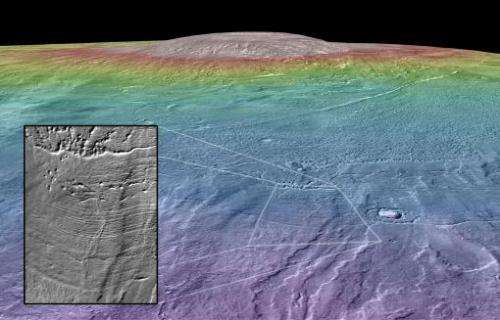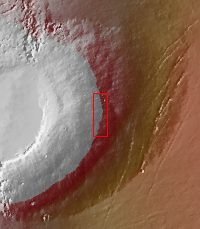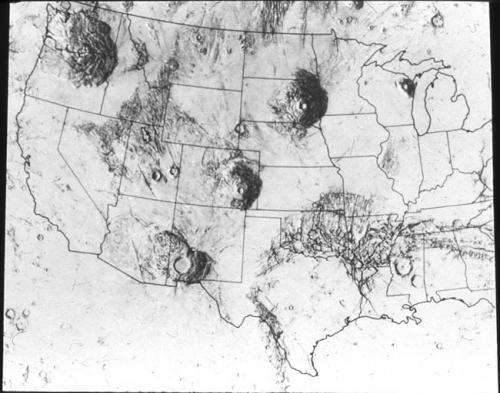Ice and fire forge a reservoir for life on Mars

Where volcanoes meet glaciers, lakes often form. This happens in many places on Earth and in at least one place off it: Arsia Mons, Mars.
Arsia Monsis one of the largest mountains in the solar system. Wispy water-ice clouds gather near its peak during the Martian afternoon. While it is only the third tallest volcano on Mars, Arsia Mons is 300 km (186 miles) wide and twice as tall as Mount Everest. If Mount Everest were to suddenly erupt today, some of the vast glaciers on its surface would melt producing floods, lakes and debris plains. We now have reason to believe this is exactly what happened on Mars when Arsia Mons was active 200 million years ago.
The evidence for these events lies along the northwest flank of the volcano. Fan-shaped-deposits (FSDs) seen by the Mars Reconnaissance Orbiter bear a striking resemblance to alluvial deposits. Such deposits are found on Earth in Death Valley, in the mountains of France, and in many places prone to flash-flooding or glacial melting. In 2012, the Mars Curiosity rover found fluvial deposits in the Gale crater. In a recently published study Kathleen Scanlon and her colleagues at Brown, Boston University, and Lancaster University in the UK showed how the FSDs and other geologic features seen near Arsia Mons are best explained by glacial deposits and enormous quantities of water.
"The term 'fan shaped deposit' usually refers to the whole glacial deposit, which was mostly created by ice that was frozen to its bed," said Scanlon, "While we think all the glaciovolcanic edifices in the FSD had englacial lakes surrounding them, the outflow channels at the northwestern edge of the deposit are the only evidence we have for the flow, per se, of large quantities of water here."
On Earth, lava that erupts beneath a glacier leaves behind traces similar to what we see when we look at the surface of Mars. Here, lava flowing under a glacier is rapidly cooled into jagged volcanic rock. In the Arsia Mons region of Mars, there are such ridges and mounds. The Arsia Mons region also features pillow lava formations: puffed-up looking patches of soil appear on Earth when lava flows through water.
"Pillow lava formations are just lava flows that form thick 'blob' shapes when water-either from melted glacial ice or at the bottom of an ocean-rapidly 'freezes' the lava at its edges," said Scanlon.

Scanlon and colleagues also found what might be an outwash plain from a massive outpouring of glacial water. In Iceland, where volcanoes are covered in glaciers, the world "jökulhlaup" means "glacier outburst floods". A jökulhlaup, or something that looks like one, was found in a region below where the volcano would have been burning beneath the glacier.
Most importantly for habitability, the recent paper maintains that the heat from the volcano would have liquified parts of the glacier into large lakes.
Estimates set the volume of the melted glacial deposit on Arsia Mons to hundreds of cubic kilometers. 100 cubic kilometers comes out to about 40 million Olympic-sized swimming pools. If that amount of water were organized into two lakes, each lake would have been approximately 30% the size of Lake Tahoe, the second deepest lake in the US.
It is estimated that these lakes persisted beneath the glacier on the northwestern slope of Arsia Mons for hundreds if not thousands of years.
On Earth, mirco-habitats exist in such glaciovolcanic lake environments. While the glacial lakes on Mars may or may not have persisted long enough for life to evolve de novo, life already present in the area or on the surface may have found refuge in these lakes in the not-so-distant past.
"The exciting thing about glaciovolcanic lakes in the Arsia Mons FSD is that they are very recent, geologically speaking," said Scanlon, "If life formed long ago on Mars and managed to survive at the surface in some dormant form and then colonize environments like these, these environments would have provided some of the few chances in recent times for life to flourish."

This find is an even more interesting prospect in light of the fact the Arsia Mons volcano may be dormant rather than extinct. Either way, according to Brown geologist Jim Head, there may be residual ice from that time remaining in the Arsia Mons region.
"Remnant craters and ridges strongly suggest that some of the glacial ice remains buried below rock and soil debris," said Head. "That's interesting from a scientific point of view because it likely preserves in tiny bubbles a record of the atmosphere of Mars hundreds of millions of years ago. An existing ice deposit might also be an exploitable water source for future human exploration."
If these calculations are correct, these Arsia glaciovolcanic geologic features were created only hundreds of millions of years ago. Any life already extent could have found shelter there between the fire and the ice. Evidence of such may remain in the ice itself or the rock of Arsia Mons, making this region an excellent target in the search for life on Mars. If this especially true if evidence of life is unearthed in the Gale Crater, which is billions of years old.
Said Scanlon, "If signs of past life are ever found at those older sites, then Arsia Mons would be the next place I would want to go."
Provided by Astrobio.net





















